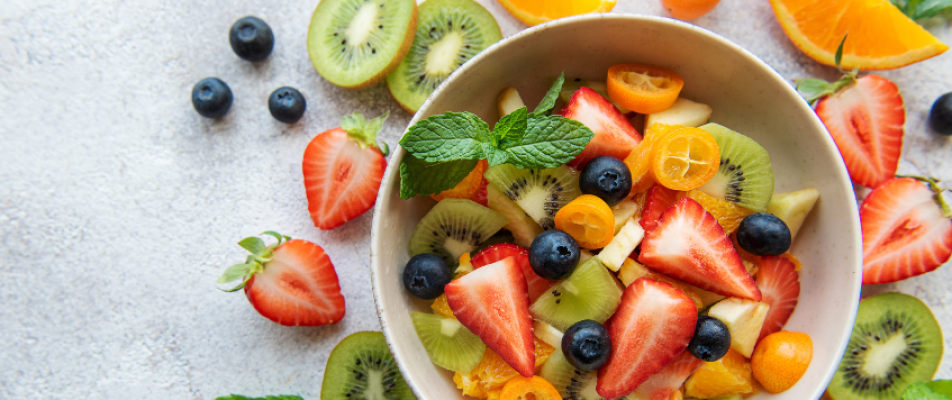
Is Fruit Actually Good for You?
Here’s how to get the most out of these nutrient-filled seasonal beauties.
I’m seeing fruit that is big, beautiful and enticing at the farmers market this month. So many shades of deep, dark beautiful colors fill the entryway at our local grocery stores, it seems as if there is a convergence of fruits at their peak.
Here’s what’s in season in Colorado late summer:
- Apricots
- Blackberries
- Cantaloupes
- Honeydew and other melons
- Nectarines
- Peaches
- Plums and pluots
- Raspberries
But is Fruit Actually Good for You?
Fruit in general is quite good for you, each providing different amounts of:
- Vitamins
- Minerals
- Antioxidants/phytonutrients
- Soluble fiber (good for gut biome)
- Non-soluble fiber (good for bowel health)
Each fruit gives us a different combination of goodness. So, if you are a fruit eater, enjoy a variety of different fruits daily. Pepper your veggie-filled diet with fruit on salads, as a side, as a snack or dessert.
Fruit is considered a whole unprocessed food, which is generally considered healthy – much healthier than a processed high-fructose food. BUT, some fruits are higher in sugars (fructose). Are they still healthy? The answer is yes. Although some fruits have more and less sugar, all whole fruits also have fiber and other good-for-you substances. It’s rare to get excessive amounts of fructose from whole fruit.
For most, the amount of sugar/fructose that is in fruit is safe to eat because the fiber from the fruit slows down the sugars and makes you full–so you won’t eat that much. Large amounts of fructose sugars can cause harm to people in serious fabricated excess – like high fructose corn syrup/sodas, etc. Those “foods” are also void of all the other goodness that fresh fruit provides. So, eat fresh fruit and enjoy it, knowing it is giving you lots of building block nutrition.
Is Dried Fruit as Healthy as Fresh Fruit?
I prefer you eat fresh whole fruit over dried fruit. BUT, dried fruit over other processed snacks.
One piece of dried fruit contains about the same amount of nutrients as fresh, with the exception of less vitamin C. The downside of dried fruit (as far as nutrient density) is that they contain 38–66% more concentrated sugars. So, a little dried fruit is great–but, please, don’t over do it. Also, some dried fruit contains sulfites, which are added to preserve color, and can upset digestion.
The Lowdown on Rocky Ford Melons
It’s melon season in Colorado, so we decided to dig into the why and how of cantaloupe nutrition. Cantaloupe seems a little under the radar to me. It’s delicious, but not talked about or served that much. Good cantaloupe – and it’s so good right now – has a greenish-white exterior and is gently firm to the touch. The inside of the melon is bright orange, juicy and sweet.
Cantaloupe is high in beta-carotene and Vitamin A
Cantaloupe is a BIG source of beta-carotene – even bigger than other yellow-orange fruits including apricots, oranges, nectarines and mangos. Beta-carotene is what gives fruits and veggies their bright colors and is the precursor to Vitamin A, a powerful antioxidant and immune booster. Vitamin A is important for eye health, healthy red blood cells and a healthy immune system.
Vitamin C: 1 cup of balled cantaloupe contains over 100 percent of the recommended daily value (DV) of vitamin C (USDA). Eating vitamin C-rich foods may help reduce the duration of your next cold.
Water: Cantaloupe has high water content, at almost 90 percent. Eating cantaloupe helps you stay hydrated throughout the day.
Potassium: One wedge of a medium-sized cantaloupe gives us approximately 4% DV. Potassium is an essential electrolyte mineral. That helps keep a good water balance in the body. Eating cantaloupe after exercise helps to replenish depleted electrolytes.
Other: Cantaloupe also has folate, vitamin K, niacin, choline, calcium, magnesium, phosphorus, zinc, copper, manganese, selenium, and lots of good fiber. EAT cantaloupe!
Our Favorite Ways to Enjoy Cantaloupe
–Chunks in a smoothie
–Include in a salad
–Serve in cubes or slices as dessert
–Serve as an app as part of a charcuterie plate (or girl dinner!)
Enjoy your summer fruit bounty!
Robin
For more info on feeling your best through smarter food choices, contact our holistic nutritionists. Book a complimentary 20-minute consultation with Healthy Nest Nutrition owner Robin Hutchinson to see if our programs are right for you.
